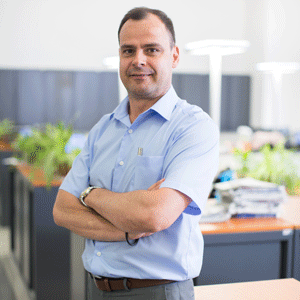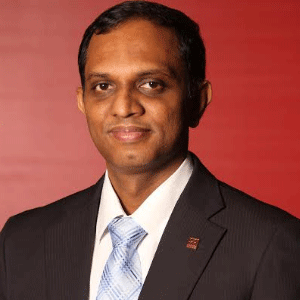THANK YOU FOR SUBSCRIBING

How IoT Integration and Innovation are Redefining the Tech Future
Amin Javed, Head of Product Innovation and Transformation at TPG Telecom

Amin Javed is a seasoned Technology Strategist with over 15 years of experience in telecommunications. He has held leadership roles at Vodafone and Kordia Solutions, driving strategic initiatives and innovative solutions. As the Head of Product Innovation and Transformation at TPG Telecom, he oversees enterprise government products and solutions, particularly focusing on emerging businesses. His portfolio includes IoT application solutions and private networks.
In an exclusive interview with APAC CIOoutlook, Javed shared his valuable insights on the latest trends, opportunities and security concerns in IoT (Internet of Things) adoption.
What are the most exciting trends in IoT right now?
IoT has been an intriguing area, primarily due to the high expectations of the market and industry experts. Interestingly, the global uptake of IoT has remained the same as anticipated, not due to a lack of technology but because the benefits and adoption rates vary. However, we are witnessing a shift, particularly with the integration of AI in government, utilities, power, energy, and logistics sectors.
The future of IoT appears bright as edge computing capabilities advance, enabling smarter end devices and better spectrum sharing. This is especially relevant in regions like Australia, where mobile coverage has historically been challenging. The significant opportunity lies in globalizing IoT solutions, particularly for car manufacturers looking to provide services to a global market through a unified system rather than fragmented local solutions.
What challenges are currently faced in the IoT industry, especially in implementation?
The IoT industry faces several key challenges, mainly due to its highly segmented value chain. Creating a one-size-fits-all solution is impossible with a wide variety of specialized sensors and devices. For example, in logistics, different tracking needs for livestock, parcels, medical devices, and pharmaceuticals require customized solutions, leading to a diverse portfolio of providers.
Connectivity, though essential, is just a small part of the broader IoT landscape. IoT projects require substantial upfront investment and a long-term outlook, often needing a decade to become profitable. Unlike consumer or fixed-line services, IoT yields low initial revenue per user or device, necessitating millions of connections to achieve economic viability.
Another challenge is spectrum resource allocation. Operators must choose between enhancing consumer networks and investing in IoT-specific networks like NB-IoT, which promise future benefits but have yet to deliver fully. The fragmented nature of IoT solutions, with many niche companies offering specialized services, further complicates the ecosystem.
With increasing IoT adoption, what security measures should organizations and individuals consider?
Security remains a significant concern as IoT adoption rises, particularly given the potential vulnerabilities in connected devices. Operators have a strategic advantage when using technologies like LTE and NB-IoT, which inherently offer more secure connections due to their design and reliance on established 3GPP standards. These technologies also benefit from using SIM cards, providing an additional layer of security compared to WiFi networks or other technologies like LoRaWAN, which operate on the shared spectrum and can be more susceptible to breaches.
Despite these built-in advantages, the fight against cyber threats is ongoing. Organizations must invest in security, ensuring compliance with evolving regulations continually. The best approach involves leveraging technologies with robust ecosystems and frequent technology upgrades, which provide better defenses against emerging threats. While security may not be the primary expertise of all stakeholders in IoT, maintaining vigilance and adhering to best practices in access control and data protection are essential for safeguarding the integrity of IoT systems.
What role does IoT play in various sectors over the next five to ten years?
IoT is set to transform several critical sectors over the next decade. In healthcare, IoT's role will be particularly impactful in specific use cases, like health monitoring and data collection. For instance, IoT devices can collect and analyze patient data, enabling predictive analytics and personalized treatment plans. However, the adoption will be highly targeted rather than widespread, focusing on areas where IoT can provide clear value.
The real game-changer is the trend towards global solutions, enabling seamless service to customers worldwide. This shift is where the most significant opportunities for IoT lie.
IoT will be instrumental in enhancing sustainability efforts in the energy and resource sectors, especially in Australia. Smart metering technologies, for example, can provide detailed insights into electricity usage, allowing for more efficient grid management and resource planning. This capability extends to other utilities, such as water, where IoT monitors and optimizes usage, contributing to broader sustainability goals.
Agriculture is another area where IoT will play a crucial role, particularly in large-scale operations. By deploying sensors and connected devices, farmers can monitor crop conditions, optimize irrigation, and enhance overall farm management. In logistics, IoT will continue to improve tracking and monitoring, ensuring the safe and efficient transport of goods. This includes monitoring environmental conditions, such as temperature and humidity, which are vital for perishable or sensitive items.
Is there any advice you would like to give professionals starting their careers in IoT?
For those beginning their careers in the IoT field, taking a holistic view of the ecosystem is essential. Many tend to focus narrowly on connectivity, but understanding IoT's broader implications and components is crucial. Patience is also vital, as IoT is not a quick-return investment. It typically requires at least a ten-year horizon to see substantial returns. Professionals should be prepared for ongoing investment and development in this space as the field evolves and matures. By adopting a long-term perspective and a comprehensive understanding of the ecosystem, new entrants can position themselves for success in this dynamic and rapidly growing industry.
Weekly Brief
I agree We use cookies on this website to enhance your user experience. By clicking any link on this page you are giving your consent for us to set cookies. More info
Read Also













